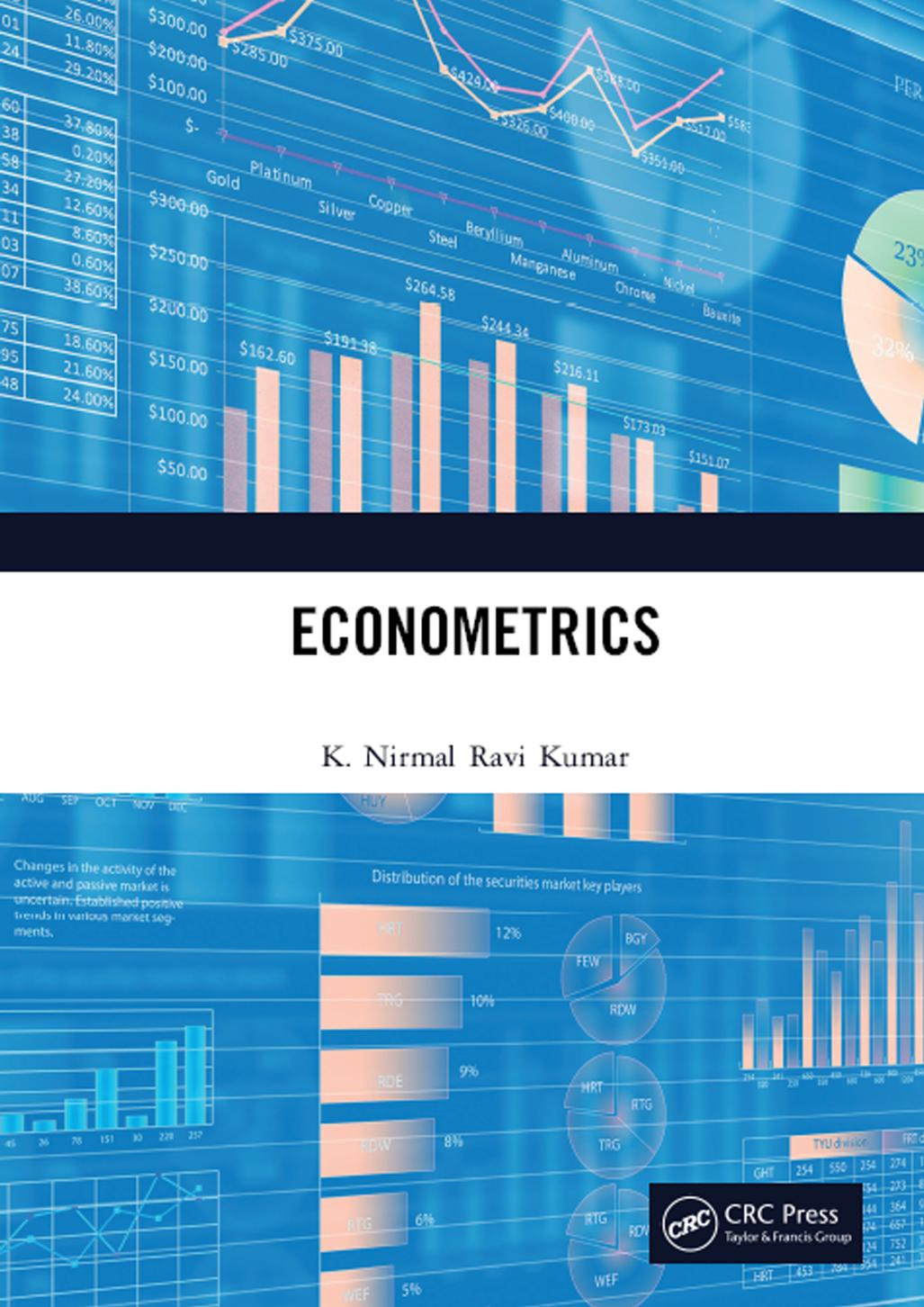Econometrics 1st edition by K Nirmal Ravi Kumar ISBN 1000096653 9781000096651
$70.00 Original price was: $70.00.$35.00Current price is: $35.00.
Instant download Econometrics after payment
Econometrics 1st edition by K Nirmal Ravi Kumar – Ebook PDF Instant Download/Delivery: 1000096653, 9781000096651
Full download Econometrics 1st edition after payment

Product details:
ISBN 10: 1000096653
ISBN 13: 9781000096651
Author: K Nirmal Ravi Kumar
This book harbors an updated and standard material on the various aspects of Econometrics. It covers both fundamental and applied aspects and is intended to serve as a basis for a course in Econometrics and attempts at satisfying a need of postgraduate and doctoral students of Economics. It is hoped that, this book will also be worthwhile to teachers, researchers, professionals etc. Note: T& F does not sell or distribute the Hardback in India, Pakistan, Nepal, Bhutan, Bangladesh and Sri Lanka.
Econometrics 1st Table of contents:
1. Definitions and Scope of Econometrics
-
Why study econometrics?: Econometrics helps quantify and test economic theories using statistical methods.
-
Types of Econometrics: Different approaches to econometric analysis, including time-series and cross-sectional econometrics.
-
Data Employed:
-
Primary vs Secondary Data: Primary data is collected firsthand, while secondary data is from pre-existing sources.
-
Cross-sectional vs Time series Data: Cross-sectional data is collected at one point in time, while time series data is collected over multiple periods.
-
Univariate, Bivariate, and Multivariate Data: Data with one, two, or more variables respectively.
-
Micro vs Macro Data: Micro data pertains to individual units, while macro data refers to aggregate national or global data.
-
-
Econometric Terminology: Key terms and definitions used in econometric analysis.
-
Methodology of Econometrics: The approach to using statistical techniques to analyze economic data.
2. Correlation
-
Pearson’s Correlation Coefficient: A measure of linear relationship between two variables.
-
Scattergram: A graphical representation to show the relationship between two variables.
-
Types of Correlation:
-
Positive, Negative, Zero Correlation: Directions of the relationship between variables.
-
Linear vs Non-Linear Correlation: Differentiates between straight-line relationships and others.
-
-
Methods for Computing Correlation: Mathematical formulae for calculating correlation coefficients.
-
Test of Significance: Assessing whether the correlation is statistically significant.
-
Coefficient of Determination (r²): Measures the proportion of variance in the dependent variable explained by the independent variable(s).
-
Spearman’s Rank Correlation: A non-parametric method to assess correlation based on ranks.
-
Partial Correlation: The relationship between two variables while controlling for a third.
3. Regression
-
Estimating Regression Equations: Derivation of regression equations through normal equations and regression coefficients.
-
Difference Between Correlation and Regression: Regression predicts values of a dependent variable, while correlation measures the strength of the relationship.
-
Tests of Significance in Regression: Evaluating the statistical significance of regression coefficients.
4. Simple Linear Regression Analysis (SLRM)
-
PRF (Population Regression Function): Represents the relationship between independent and dependent variables.
-
OLS Estimation: Ordinary Least Squares method used to estimate regression coefficients.
-
Interpretation of OLS Estimates: Understanding the meaning of regression coefficients.
-
Measures of Variation: Total, explained, and unexplained variations.
-
Goodness of Fit (r²): Assessing how well the regression line fits the data.
5. Assumptions of the Classical Linear Regression Model (CLRM)
-
Assumptions about Independent Variable and Error Term: Fundamental assumptions required for OLS to produce unbiased and efficient estimates.
6. Judging the Goodness of Parameter Estimates
-
Model Specification: Proper inclusion of variables and correct formulation of econometric models.
-
Evaluation Criteria: Statistical, economic, and econometric criteria for evaluating model estimates.
-
Forecasting: Using econometric models for future predictions.
7. Tests of Significance and Gauss-Markov Theorem
-
OLS Estimates: Understanding the properties and significance of OLS estimates.
-
Gauss-Markov Theorem: Conditions under which OLS estimators are BLUE (Best Linear Unbiased Estimators).
8. Functional Form Specifications
-
Linear and Non-Linear Models: Various functional forms such as semi-log, log-log, and polynomial models.
-
Box-Cox Test: A test used to compare different functional forms of a regression model.
9. Multiple Linear Regression Model (MLRM)
-
Differences Between SLRM and MLRM: Extension from simple linear regression (one independent variable) to multiple independent variables.
-
Assumptions in MLRM: Specific assumptions needed for valid multiple regression analysis.
-
Tests of Significance: Hypothesis testing for multiple regression coefficients.
-
Multicollinearity: Problems arising from high correlations between independent variables in MLRM.
10. Relaxing the Assumptions of CLRM
-
Dealing with Violations: Adjustments or methods to handle situations where CLRM assumptions do not hold.
11. Multicollinearity
-
Types and Causes: Identifying and addressing issues arising from high correlations between independent variables.
-
Detection and Solutions: Methods such as the Variance Inflation Factor (VIF) and Principal Component Analysis (PCA) to detect and resolve multicollinearity.
12. Heteroscedasticity
-
Detection: Methods to detect non-constant variance of the error terms, such as residual plots and formal tests.
-
Solutions: Approaches like weighted least squares (WLS) and generalized least squares (GLS) to handle heteroscedasticity.
13. Autocorrelation
-
First-Order Autoregressive Model (FOARS): Explores the relationship between error terms over time.
-
Tests for Autocorrelation: Methods such as the Durbin-Watson test and Breusch-Godfrey test for detecting autocorrelation.
-
Remedial Measures: Generalized Least Squares (GLS) and iterative methods for correcting autocorrelation.
14. Regression on Dummy Variables
-
ANOVA and ANCOVA Models: Techniques for handling categorical independent variables using dummy variables.
-
Interaction Effects: Studying how dummy variables interact with continuous variables in regression models.
-
Testing for Structural Stability: Techniques like the Chow test and use of dummy variables to test if the regression model’s parameters change over time or across groups.
People also search for Econometrics 1st
mostly harmless econometrics
financial econometrics
wooldridge econometrics
introduction to econometrics
journal of econometrics
Tags:
K Nirmal Ravi Kumar,Econometrics


